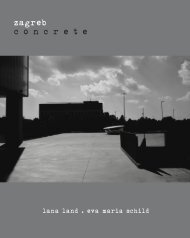zagreb abstract
- No tags were found...
You also want an ePaper? Increase the reach of your titles
YUMPU automatically turns print PDFs into web optimized ePapers that Google loves.
THE HIDDEN MANUSKRIPT OF THE CITY<br />
The relentless, fluctuating forces underlying urban life leave existential<br />
traces both elusive and unstable. This is a subject to have inspired many<br />
writers, from theoreticians like Simmel, who tends to see the metropolis as<br />
an imprint of individual or collective spiritual life, to Marshall Berman.<br />
In stating that ‘it is not possible to step into the same modernism twice‘,<br />
Berman stresses both the dynamics of the general theoretical discourse<br />
and the individual histories comprising the vast mechanism that makes up<br />
the city. This distinction or chasm between the private and the public is a<br />
function of the modernizing effects of constant building and destruction:<br />
a fundamental, performative function of the city. The chasm establishes<br />
a modernist aesthetic of resistance to the contemporary mill of change.<br />
One of the most beautiful and unusual dedications to the city is that of<br />
Allen Ginsberg, on Ghetto Defendant by The Clash: ‘Do the worm on Acropolis.<br />
Slamdance Cosmopolis. Enlighten the populace. Hungry darkness of living.<br />
Who will thirst in the pit? Hooked in necropolis. She spent a lifetime<br />
deciding. How to run from it. Addicts of metropolis...‘ Ginsberg is referring<br />
here to the complexity of relations between the individual and the public,<br />
whilst hinting at the disappearance of the intimate from the modern urban<br />
landscape.<br />
From the theoretical anticipation of the ‘global village’, the global city<br />
formed itself as a place in a perpetual state of ubiquitous exposure. On one<br />
side of the theory, theoreticians and poets strive to stand out from the<br />
torment of the General. In this context, for the ordinary citizen in the<br />
metropolis, the possibility for personal recording reveals itself through<br />
small strokes: graffiti, a spontaneous intervention, scribble, clusters of<br />
historical layers of communication and similar remnants of modernization<br />
and its vicissitudes. That is what Marian Detoni saw in his ‘Fantasy of the<br />
Deteriorated Wall‘, when he created a surface, seemingly without any real<br />
significance, which offers an intimate, self-realizing universe to the<br />
attentive and inspired eye. In such a way, one of the most important paintings<br />
in Croatian modern art was conceived.<br />
This book aims to capture the hidden manuscript of the city - that which<br />
is present in unseen urban spaces, either left there intentionally or<br />
spontaneously created over time. Contrary to the grandiose, representative<br />
portrayals of the city, often hidden in ideologies presenting the city as a<br />
platform of collectivism, this book offers an intimate micro-image of the<br />
metropolis, elevating the ephemeral and seemingly worthless to the level of<br />
the General. It is about the spontaneity of mass culture, and as such it does<br />
not seek to engage at the spectacular, ideological level of the representative<br />
culture. Rather, the book operates at a capillary level, tracing<br />
personal ideas and emotional pictures, almost a psychogram of the city, the<br />
less visible city; a Zagreb which reveals itself as unfamiliar or previously<br />
unseen.<br />
Feđa Vukić



